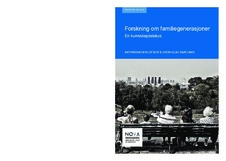| dc.description.abstract | This state of the art report is commissioned by the Ministry of Children, Equality and Social Inclusion. It summarises Norwegian and international research on the relationships between family generations, and identifies knowledge gaps and recommendations for future research in this area. The report is organised in three sections: Part 1: The family in society and in the lives of individuals, Part 2: Solidarity and exchange between the generations, Part 3: Resources and new risks – knowledge and knowledge gaps. Part 1: Introduction: The family in society and in the lives of individuals Is the modern family in crisis and family generations in conflict, as often stated in media and public discourse? What are myths and what are realities? Other social institutions, such as public education and the welfare state, may have taken over many of the tasks that earlier were the family’s responsibilities. However, the modern family is not reduced to an isolated nuclear family, with only few or weak ties to the older generation(s), as suggested by Parsons in the 1950s. The “modified extended family” is still a reality. Grandparents help out when children and grandchildren are in need. Adult children – many seniors themselves– contribute to the care of their older parents. Moreover, there is still considerable exchange of company, comfort, and money between family generations. Part 1 maps out the structure and demography of the modern Norwegian family, and illustrates how family structures and relationships have changed over time. The intergenerational solidarity model is then presented as a conceptual tool for analysing intergenerational family relationships. Here solidarity is seen as played out along several dimensions: socially (contact), emotionally (emotional closeness or conflict), functionally (mutual help), and normatively (duty, obligations). Part 2: Solidarity and exchanges between the generations Part 2 summarises research on each of the above-mentioned dimensions. In general, our review of Norwegian research reveal considerable intergenerational family solidarity and a remarkable stability over time. The majority of older parents have frequent contact with their adult children. More than 60 per cent meet at least weekly. Only a few live together with adult children today – fewer than earlier, and considerably fewer then in more family-oriented countries and welfare states in Southern and Eastern Europe. Most do, however, have children living close by, although not under the same roof. This seems to be in accordance with the ideals of both generations: Close, but not too close. Relationships are reported to be emotionally close by a majority, but more so by parents than by children, in line with the “developmental stake hypothesis”. Normative solidarity also seems to be quite robust, but finds new ways of being played out, in forms and manners that are easier to combine with modern lives and practices, including women’s (daughters’) paid occupation. Data from the Norwegian Life-course, Ageing and Generation Study (NorLAG) shows that normative solidarity, as indicated by filial responsibility norms, may have declined over the last decade, but whether the change represents a persisting trend, or a temporal fluctuation, is so far not clear. Help exchanges usually flow from parents to children most of life, but directions tend to change beyond 70-75, when children often become net help providers. In general, the family takes a greater and more direct responsibility in countries with a more collectivist family culture and a less developed welfare state. However, men and women are just as likely, or even more likely, to be involved in family care (such as grandchild and parent care) in Scandinavian welfare states, but then often in less intensive forms, and usually as a supplement, not an alternative, to the welfare state. Part 3: Resources and new risks – knowledge and knowledge gaps. Part 3 looks ahead and identifies knowledge gaps and the need for future research. The modern family takes many forms, all with an equal right to be respected. Part of the variation is rooted in migration from other countries and cultures. We know currently little about whether, and how, families with immigrant background will adapt to Norwegian patterns. New family forms and relations are becoming more common, including cohabitation, same sex partnerships and marriages, as well as step relationships. These developments illustrate that the family is quite flexible, and as such quite strong, but new family forms may also represent new risks and vulnerabilities. For example, increasing divorce rates are found to weaken intergenerational solidarity, in particular vis-ö -vis fathers. The report points to four areas in need of research: The interplay (of responsibilities and practices) between the family and the welfare state, the conflict between commitments to family and work, the challenges of multicultural families, and family vulnerability and risks more generally. For each issue, gender equality should be addressed. There is also a need for more knowledge about family solidarity and social inequality. Our knowledge about family generations in Norway needs to be updated. Longitudinal studies, where persons and families are followed over time, are of particular importance. We know too little about what drives families and family relationships, including the relative role of norms and attachments, needs and self-interest. Moreover, better knowledge about family generations may help us to understand the relationship between generations at the societal level, the so-called generational contract, which is the very fundament that both families and welfare states are grounded on. | en |
